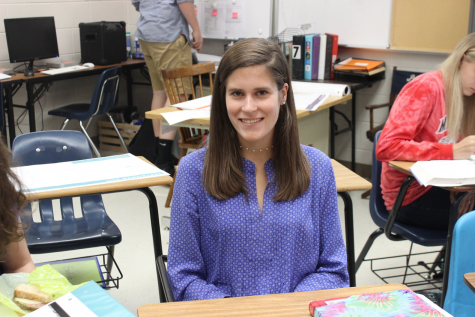Welcoming Strangers
June 13, 2017
Between 2014 and 2016, more than 2.1 million people fled to Europe, most seeking refuge from war torn countries in the Middle East and North Africa. In a panel discussion at RCHS, on February 17, professors and students from Washington and Lee University spoke to high school students about immigration challenges and opportunities facing Europe and the United States.
Although there are many reasons to be skeptical about Europe’s ability to cope with the challenges of mass immigration, there are reasons to be hopeful.
According to Professor Paul A. Youngman — head of the Department of German and Russian, and Chair of the Digital Humanities Working Group at Washington and Lee University — on the one hand, the tsunami of foreigners flowing into traditional Western European countries is threatening to local inhabitants, in terms of language and cultural differences. These foreigners represent competition for jobs, housing, and social services, all of which fuel the fire of xenophobia. On the other hand, several European countries have been successful, at the local level, implementing initiatives to welcome and integrate immigrants into their communities.
I believe both the challenge and the opportunity, for Europe and the United States, is to learn from and build upon the successful models, and to avoid those that have resulted in failure.
As Professor Youngman points out, big surges in immigration can be overwhelming for local populations, causing some countries, like France and Austria, to respond by cordoning them off into large holding areas. In Calais, France, for example, Professor Mohamad Kamara, associate Professor of French at Washington and Lee University, explained that incoming immigrants were placed into crowded camps known as “The Jungle,” where they were supposed to live until able to find new homes. But when thousands of people are crowded into one area, straining local resources and infrastructure, it can overwhelm both immigrants and locals, causing resentment between both groups.
In response to the overflow of ‘The Jungle,’ Professor Kamara explained that France, “closed [‘The Jungle’] back in November, and the 5,600 occupants of that camp were moved in buses to various parts of France, where they were processed. Those that were qualified for a salary status could apply and be moved to the next stage [permanent shelters].”
Anna Jerusalem, a Foreign Language Teaching Assistant at Washington and Lee University, and a student at the University of Graz, in Austria, says her country faced the same issue of overpopulation and decided to close its borders, instead, allowing authorities to reject any immigrants trying to enter.
Germany has taken a different approach. Rather than creating large camps/holding areas, Germany focuses on distributing immigrants to different parts of the country as they arrive, allowing local officials to address immigrant needs on a case-by-case basis.
Professor Paul A. Youngman explained that, “There is no such thing as an illegal alien or even an undocumented alien [in Germany]. They call them refugees, because when refugees come to Germany, it behooves them to immediately report because you get an apartment, you get a debit card that’s part of an EU plan, with a little bit of cash in there.”
In St. Ingbert, Germany, a small town approximately the size of Lexington, Va., I learned from my German grandparents that the children of immigrant families are enrolled directly into the school system, where they are taught the German language. At the annual “Stadtfest,” or town festival, immigrant families are able to sell merchandise, make ethnic foods, and play traditional music from their homelands, with the support of local (German) citizens.
Anna Jerusalem discussed the efforts her town and church, in Austria, made to welcome the immigrants, before her government decided to close the country’s borders to them.
“In my university, we got together and tried to come up with language programs for the immigrants and for refugees. We invited them into our homes, we informed them about our culture, but also, and this is in my opinion very, very important, we not only informed the refugees or immigrants about the culture they’re in now, we have to inform ourselves and people in Europe about their situations. You have to learn about their culture,” said Jerusalem.
Institutions, such as churches, “set up programs to teach the language, to cook together with these people, to show them how to use the public transportation system, and they really became friends,” said Jerusalem.
Understanding the plight of immigrants is as important as understanding the fears and concerns of the local people they want to live among. Organized support, like that provided by Jerusalem and many of her fellow classmates at the University of Graz, can help to minimize the difficulties brought about by the abrupt introduction of new immigrants into different countries and cultures. Developing empathy and cultural awareness, through the education of both immigrants and the citizens they move in to live among, can lead to greater understanding and acceptance.
In St. Ingbert, Germany, and Graz, Austria, local citizens have made committed efforts to welcome immigrants, by directly involving them in everyday local life, and by building strong connections with the newcomers, early on. Admittedly, these efforts aren’t going to fix the immigration crisis immediately. But, I believe that individual people, acting at the local level, is how positive changes will be made. As Mother Teresa said, while striving to help India’s many sick and poor people, “I never look at the masses as my responsibility. I look at the individual. I can love only one person at a time. I can feed only one person at a time. Just one, one, one.”







